Marianne Milne Simpson was my great-aunt, a woman whose first name enjoyed many spellings. Why was she in India in 1907 when she met my great uncle Jack Stevenson? How did they meet? And where was she from?
Methlick
I can answer at least the final question, about Marianne’s origins. She grew up on a large farm in lush rural Aberdeenshire, and had ancestors from that region. That part of Scotland is not so far from places familiar to me, but has some noticeably exotic and distinctive place-names. To Marianne, Methlick was the local village, and Ythan the local river.
“Methlick” conjours up the Picts (who who saw off Romans and Vikings) while other local place-names show the later influences of Gaelic and Scots contact and settlement. All these languages are related to each other, more or less closely. They have a common ancestor, and are siblings or cousins. The same is true of their more distant relatives in the east, like Hindi, Sanskrit and Bengali. They/we are all in the Indo-European language tree together.
Marianne’s origins
Thank goodness for FIBIS, the Families in British India Society. A search for my great uncle Jack had provided a transcription of an announcement in the Times of India under the heading of Marriages as reported in ‘Domestic Occurrences’:
On the 4th April 1907 (at Jalna), John Black Stevenson MB ChB (of Parbhani), married:
“Marie
youngest daughter of
Samuel Simpson Esq
Wardford
Aberdeenshire
Scotland“
The use of “Marie” rather than “Marianne” led to a delay… in part because her husband would one day be remarried. To someone called Marie! But I’ve now found Marianne’s birth certificate, and we will see that there’s no doubt that it’s the right one. Marianne Milne Simpson was born on 12th October 1865 (and registered on the 30th) in Findlatree, Tough, in Aberdeenshire.

Her father was Samuel Simpson, farmer, and her mother was Sophia Adam, both alive at that time. Her parents had been married on 1st February 1855, also in Tough Parish, and their places of residence was indicated on their marriage certificate thus:
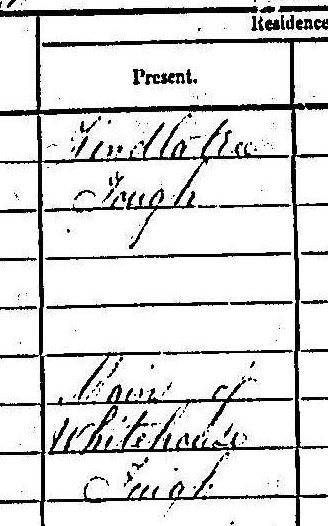
From her parents’ marriage certificate, we can also see that Samuel was aged 31 when he married, and was a farmer. The marriage certificate says further that he was born on 3rd July 1823 in the same parish. Sophia was aged 26, and as we can see above was living at Mains of Whitehouse, also in Tough. Sophia had been born on 1st March 1828 in Kemnay (also Aberdeenshire). All four of their parents were also named (see below).
What great information the new civil Scottish certificates provided in 1855!
Findlatree, Tough
The contemporary Ordnance Survey Gazetteer of place-names 1856-1871 (at Scotland’s Places website) lists these places. Findlatree (Vol 86 OS/1/86/16) was “A large farmsteading consisting of a dwelling house and office houses, all thatched and in good repair. Property of Mr Byres.” (Near it, Craich was also owned by Mr Byers: “A cluster of thatched dwelling houses and office houses, all in good condition.”) Mains of Whitehouse (Volume 86 OS1/1/86/10), was “A very large farmsteading. lately erected. dwelling house 2 storys, with an excellent court of, offices detatched therefrom. one story. all slated and in excellent repair. The property of A. Farquharson Esqr. of Whitehouse. (sic)” Findlatree lies west of Kirkton of Tough near Lynturk and Whitehouse just to the north east of these. The main local settlement nowadays is Alford, and these farms lie under 5 miles to the south and east of it, and about 3 miles from each other on opposite sides of (Kirkton of) Tough, with its historic graveyard. See an 1865 map (look centre left), or the earlier:

There is one reason for sure this wonderful farming area around Tough should be familiar to you: it’s where the Aberdeen Angus beef breed comes from.
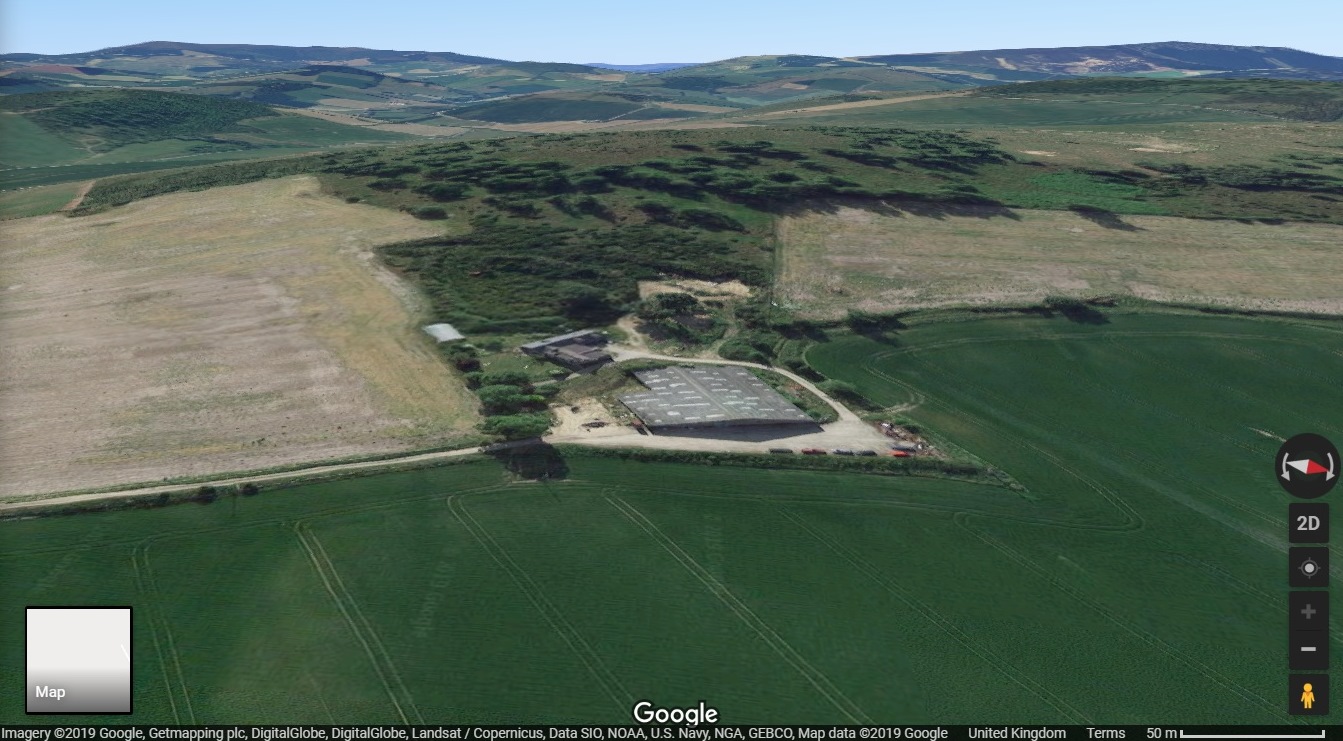
Map reference 57.205733, -2.669584
Back to Wardford
Another blog is oriented towards Marianne’s future husband (i.e. my great uncle Dr John Black Stevenson) and their lives together and family. Here, I will look at the family background of Marianne (or Marie, as she seems to be named in the newspaper, from the transcription) as a young woman at Wardford.
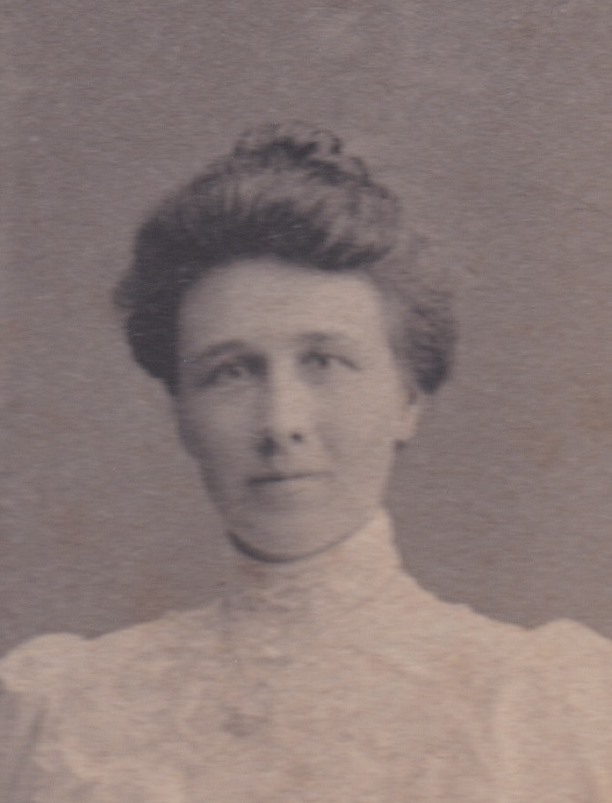
Marianne Milne Simpson (12 October 1865 – 17 November 1933), taken I think at the time of her wedding (1907, aged around 42) to John Black Stevenson
Wardford was in the parish of Methlick. The village of that name lies about 30 miles north east of Findlatree. Methlick’s Free Church (1780) was replaced by a new Church which was finally competed in 1866. Christianity appears to reach back in this area to the 5th century, under St. Ninian, who built the first church in the NE of Scotland here, according to the church website.
Ythan
Wardford Farm is nestled south of a bend in the River Ythan (/ˈaɪθən/), and a few hundred metres north west of the village of Methlick. Between the farm and the Ythan lies a wood.
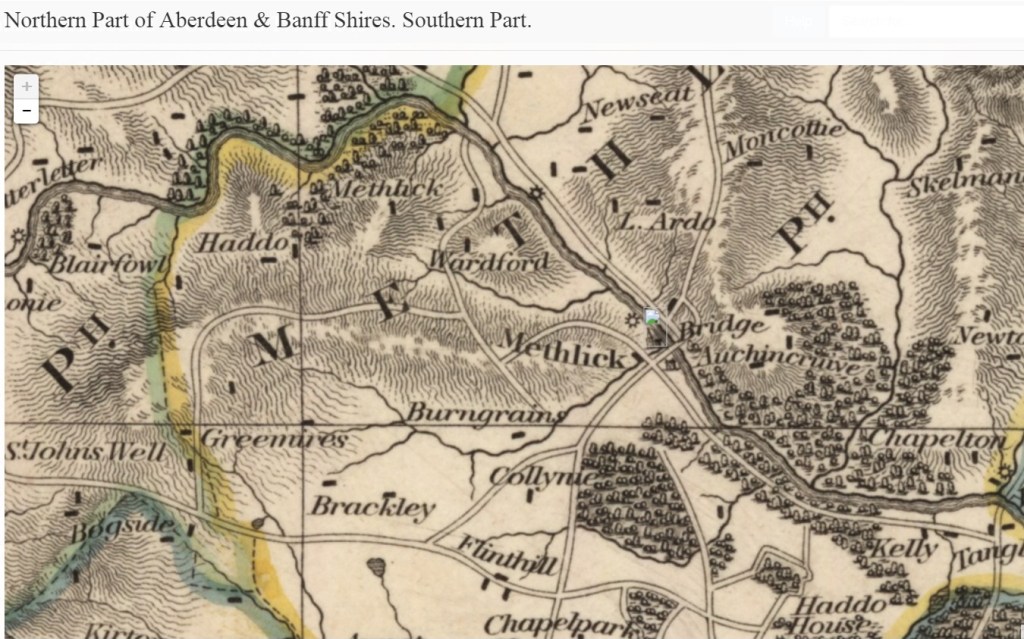
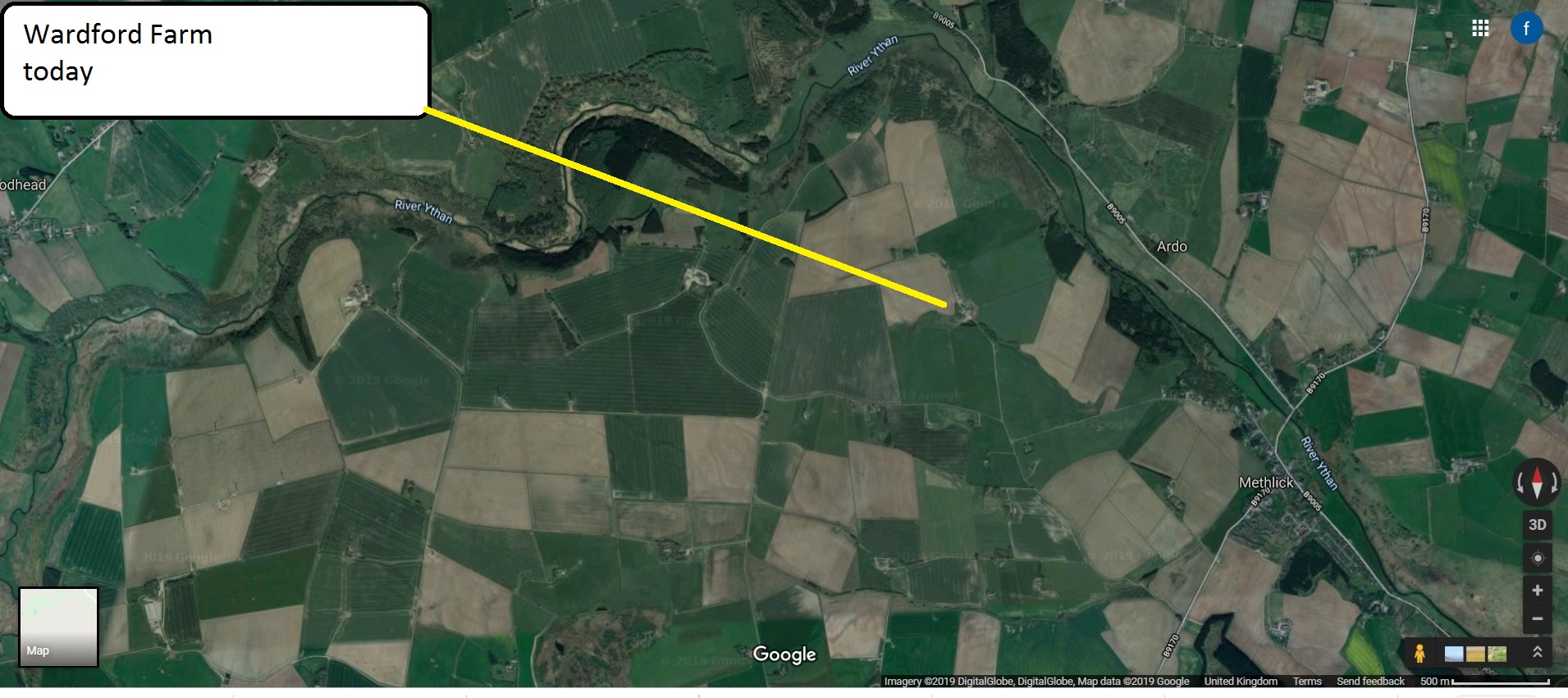
The Wood of Wardford is the Aberdeenshire OS Name Books, 1865-1871 (volume 61 OS1/1/61/52). The area’s landowner was the Earl of Aberdeen, and information in the index about spelling etc. was provided by Samuel and other trusted local authorities: Mr. S. Simpson of Wardford, Mr. John Duncan of Chapelhaugh and Mr. Alexander Smith of Gowkstone.
As for the farm properties nestled in that area, Wardford Farm itself (volume 61 OS1/1/61/11), along with Middleplough, got their authority from the spelling from the Valuation Roll but also “Mr. S. Simpson Occupier” and “Mr. John Irvine Milltown”, with Milltown’s name arising from the Valuation Roll and “Mr. John Irvine Occupier” and his neighbour “Mr. S. Simpson Wardford”. Like the wood, these farms were owned by the Earl of Aberdeen.
Middleplough was “a farm consisting of a good dwelling house and garden and a steading of good farm offices. Situated abt. [about] 1/4 of a mile n.w. [north west] of Wardford.” Wardford itself was “A farm consisting of two dwellings with a few Cottages Gardens and a good farm Steading. Situated about 1/2 a mile W. [West] of Polesburn Wood” and it seems “Middleplough and Wardford are at present into one Farm” Milltown was “a Farm Consisting of a good dwelling house and Garden and a Steading of good farm offices, situated a little N. [North] of the Co. [County] Road and abt. [about] 3/4 of a mile N.E. [North East] of Wardford.”

Samuel was also cited as a source for the name and spelling of Lochcam Pot, which was “An old name of a Pool in the River Ythan a few yds. [yards] below the Conflux of Poles Burn with Said River Ythan, Extending abt. [about] 6 Chains down the River – The name seems to signify Crooked Pool Loch – Cam.”
Statistical accounts and famous parishoners
The Old and the New Statistical Accounts give a broad description of the parish of Methlick, in the County of Aberdeen.
- OSA, Vol. IV, 1792 | Rev. Mr Archibald Knolls
- NSA, Vol. XII, 1845 | Rev. James Whyte (Written August 1842) [link]
The New account says “If one may judge from the hale old age which not a few reach in this parish, the climate may be said to be salubrious”. The river had salmon, trout, and “at one time, it was more famous for its pearl fishery than it is at present” not least because hundreds of shellfish would be destroyed for each “prize” (all p963). The placenames are evocative: Monquhitter, Inverebrie, Balquhindachy, Belnagoak, Skilmoney, Fyvie. The best land lay near the river, “yellow loam on a bottom of rock and gravel” (p964). In gardens, raspberry, gooseberry, currant and strawberry are “produced in abundance, and of excellent quality”, but apples, pears and cherries do not do well. (p965).
The Earl of Aberdeen did not own merely Wardford farm, but the whole parish. In 1845, he was the British Secretary of State for Foreign Affairs. In total, the parish had 354 inhabited houses, with 92 people living in Methlick and 1,645 elsewhere. In the parish, 2 people were blind, 1 fatuous, and none deaf and dumb. “Habitual intemperence is rarely met within the parish; and the average number of illegitimate births in the parish within the three years previous to 1840 was 11, of which 7 were ante-nuptual cases.The attendance on the ordinances of religion is exemplary.” (p968).
The famous local people noted in 1842 were Dr George Cheyne (1671-1743). He recovered from obesity (400lb/200kg) in London (caused by over-indulgence in drink and red meat) through a flexitarian diet. He became a fashionable health, diet, and exercise guru and author, in the city of Bath in the 1720s. He was famous for decades and still retains a profile and positive reputation in the histories of preventative medicine and vegetarianism. Dr Charles Maitland (~1668-1748), a surgeon, was the first to perform inoculation (“variolation”) professionally in Britain, for smallpox, in 1721… somewhat reluctantly (in case it went wrong), having previously assisted in the process in Constantinople for a child of Lady Mary Wortley Montagu. He then was licensed to experiment on prisoners in Newgate Prison in 1722, all of whom survived, and one of whom became immune to the disease. Later that year, Queen Caroline had her eldest son, Frederick, Prince of Wales, successfully inoculated by Maitland. He was the son of George II and father of George III.
Census information on Marianne
1881
The Simpsons’ location in the 1881 census index was at a farm at Wardford, Methlick parish. Given the additional information above, it seems they lived in the farmhouses at Wardford, but had combined the land with Middleplough. The census conveys that the farm was extensive: 380 acres. The Simpsons in 1881 (Ref 221/ 2/ 3) were a household of four unmarried young women (“farmer’s daughters”). The farmland was, and is, in a beautiful rural area still producing top quality produce today. In 1881, the farm employed 8 men, 1 woman and a boy.
- Samuel, head, aged 57, from Tough parish, Aberdeenshire
- Sophia, wife, aged 53, from Kemnay, Aberdeenshire
- Elsie, aged 24 [? Elspet b.1856, Ref. 244/ 26 so more like aged 25-26?]
- Margaret, aged 21 [? Margaret Mackay b.1860, Ref. 244/ 23 ]
- Sophia, aged 17 [? b. 1863, Ref. Tough 244/ 16]
- Mary A. M., aged 15 [i.e. Mari-Anne Milne, b. 12/10/1865]
Given that their parents had been married in 1855, it’s likely that Elsie was the eldest in the family, but there might have been brothers aged around 23 or 19 who had moved away.
Four people (relatives) were visiting on census day. “Mary A.” Milne (a widow aged 49 with an annuity) had been born in Kemnay (around 1832). Joanna M. B. L. Milne aged 18, student, born in Peterhead, was presumably her daughter (b. around 1863). My guess is that this Mary was the “Mary A.” Adam who in 1861 married a John Milne (Ref 168/1 126 St Nicholas). Jumping to mind is the idea that she was Sophia’s younger sister; making Joanna Milne (born approx 1863) Marianne’s cousin. Either that, or Mary A. Milne nee Adam was herself a cousin or other relative of Sophia’s. See below.
As an aside, there were a few Milne families living in Methlick: maybe John was related to one of them, or perhaps his Milne family was from elsewhere. Ah, very late in the day it has occurred to me that Marianne Milne Simpson’s middle name, given to her in 1865, is at least not incompatible with Mary A. Adam marrying John Milne in 1861.
Also visiting was Margaret Adam, another annuitant, aged 54 and unmarried, from Kemnay. She was likely to have been Marianne’s aunt, i.e. Sophia’s older sister. The final visitor was Peter C. Mitchell, aged 16, a student, born in Dunfermline. Also living on the farm were Isabella Brodie aged 25 (general servant from Cluny), William Cassie aged 12, a shepherd boy from… “Mettlehill”? … or is that “Methlick”? Yes: William Cassie was from Methlick, I can see a more legible version of the census taker’s handwriting on the same page).

1891
Ten years later, Samuel and Sophia Simpson’s household was similar (1891 census, Ref 221/ 2/ 6). Three daughters (Elspet, Sophia and Marianne M) were at home and unmarried and (hence) in the family home, aged 33, 26 and 24 respectively. No occupation is indicated other than might be expected as a farmer’s daughter: but this was a rich enough farm, so they can be though of as waiting in their local society for marriage, and helping to run the household in some way, not undertaking physical work. Four servants were living on the farm: Jane Florence, aged 33 from England; Alexander Anderson and Alexander Bruce (agricultural labourers), both aged 20; Charles G. Cumming, likewise (aged 19).
1901
In 1901, Samuel was dead, and I doubt the remnants of the family were in the same home. I’ve not tracked them, because the key question is whether Marianne was still in Scotland. It is not obvious without more work whether the various Ma* Simpsons of the right age are her, or not. My best guess is that she was in Edinburgh (St. Giles), aged 34. ( Ref 685/4 56/ 6 ). Ancestry’s online hint thinks so too, I think, and there may be a shipping emigration data point somewhere.
1911
Marianne or in this case “Marian Stevenson” had returned from India with her three year old daughter Marjory, and they were (living?) in Hampstead in London with her elder sister “Sophia Simpson Ritchie”, who had married an older man, Alexander Ritchie (by then aged 61), an iron merchant from Glasgow. Both sisters’ ages are under-estimated in the census return (39 and 40) by about 5 years! But it’s them right enough: the sisters are listed as having being born in Aberdeen, and Marjory as having been born in India.
Marianne’s siblings (from census data)
1871
Looking back in time now to 1871, when Marianne was only around 6 years old, I thought I would check to see if she had any other siblings, in addition to her three older sisters. The census for 1871 looks similar to 1881, with the 380 acre farm employing 7 labourers, two women and a boy. The family of Samuel (aged 47) and Sophia (aged 43) were:
- Margaret, aged 11
- Martha Jane, aged 9 [?b. 1862, Tough, Ref 244/ 4 ]
- Sophia, aged 7
- Marianne, aged 5.
From this, it appears there were no brothers for the five girls, but it remains possible that there was one between Margaret and Elsie/Elspet (the latter would have been aged 16 in 1871). Martha Jane who was not at home in the 1881 census may have married Alexander G Mowat in 1893 and/or David Lindsay in 1898. There is no indication that she died before the 1881 census in childhood.
1861
Similarly, 10 years back to just 6 years after the marriage of Samuel and Sophia, the census index for 1861 lists the family of five (Tough Ref. 244/ 2/ 12 ) as being Margaret (aged 1), Elsie (aged 4) but also Elizabeth A (aged 3), and the parents aged 37 & 33. That’s them. There are too many Simpsons in the area to be sure about the two girls close in age called Elsie and Elizabeth A from the birth index. I can’t even be sure which of them was recorded as Elsie aged 24 in 1881 or Elspet aged 33 in 1891. This will be easy to work out with a day pass to Scotland’s People, but is too expensive just to download birth certificates on the off-chance of quickly getting lucky, let alone to search for their marriages and/or deaths.
As noted above, Marianne’s birth certificate shows she had been born in Findlatree in 1865, so I expect the family moved to Wardford between 1865 and 1871.
Marianne’s parents and grandparents
Census data from 1841 and 1851
Intriguingly, in the 1851 census for Tough, there are only four Simpsons, and three were living together (perhaps with others, which I can find out from the certificate): Samuel (aged 27, which fits perfectly), an Elizabeth aged 26, and an Ann aged 20. These are surely Marianne’s father and two others. In the 1841 census, one household has Samuel (70), Martha (55), Samuel (15), Elizabeth (15) and Ann (10), which will be the same family (given that ages were rounded too the nearest five years), and suggests that Samuel had (at least) two sisters. See more below.
In the 1851 census, there is only one likely hit for Sophia Adam, aged 22, in Cluny, a few miles east of Kirkton of Tough (Ref 181/ 2/ 6). It’s a very unusual name: there were only three people called Sophia Adam in Scotland. There were 10 people with surname Adam in Cluny, but only one co-indexed with Sophia: Margaret (aged 24). This is who I guess to be Sophia’s sister, two years older, who was visiting the Simpson household in 1881. In 1841, there was a Sophia aged 13, in Kemnay (Ref 207/ 4/ 5), out of only five in total in Scotland, including a 70 year old woman in Aberdeen and a baby aged 2 in the nearby Monymusk. In 1841 Sophia Adams was co-indexed with only one other person called Adam, Alexander (16), though there were 23 people with the Adams surname in Kemnay. I expect he was her brother.
BMDs in the OPRs
From Marianne’s parents’ marriage certificate (1st February 1855) we know that her father Samuel’s parents were Samuel Simpson, a farmer, and Martha Stephen. From the census information above, the strong likelihood is that they were born around 1770 and 1785 respectively, and died between 1841 and 1851 in Tough. OPRs (Old Parish Records, from before 1855) might help with the death dates: a Samuel Simpson died in Tough on 21/03/1850 aged 83, which is probably him, putting his birth year around 1767. There is an even better contender in the index, for Martha: a Martha Stephen (linked to Samuel Simpson) died 28/04/1846, aged 61, so I am confident this was her, meaning that she was born around 1785. I can’t spot their marriage, or their births.
Marianne’s own father Samuel died before Marianne’s wedding in India in 1907, on 14th August 1897 in Methlick aged 74 (ref 221/ 24 ) of a stroke. (The witness was his daughter Elsie Simpson, one of the two mentioned above, who was therefore unmarried.) Marianne’s mother Sophia died I think in 1912, in St Machar district (ref 168/2 51 not checked), aged 83, five years after Marianne’s marriage in India.
The maternal grandparents of Marianne were also named of course on her parents’ 1855 marriage certificate: John Adam (farmer) and Elspet Leslie, as shown in the tree. Tracking them further might be possible using earlier census and Old Parish Records, but their surnames are not uncommon, and I haven’t spotted them in the 1841 or 1851 census, and so it’s a line I hope someone else has pursued, and will link up with. I guess they died before 1841 somewhere else, or records are missing/lost. (See now “Ancestry” below.)
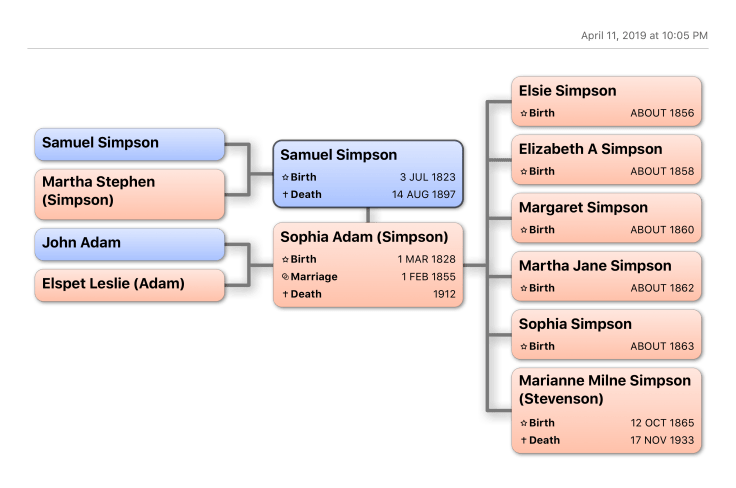
More family, maybe
OPR records for Kemnay (Parish 207, with parents JOHN ADAM/ELSPET LESLIE) do however provide likely siblings for Sophia, tying in with what we have seen above fairly well for Sophia’s date of birth – though the age of Alexander in the 1841 census seems to be wrong because the OPR records suggest he was 9 years older than her, not just 3 years older. These are all baptisms/christenings I think: Sophia’s birthday was 1st March 1828.
| ADAM | ALEXANDER | M | 30/04/1819 | 207/ | 10 306 |
| ADAM | ALEXANDER | M | 30/04/1819 | 207/ | 10 308 |
| ADAM | CHRISTIAN | F | 07/09/1820 | 207/ | 20 5 |
| ADAM | JANE ELISABETH | F | 25/07/1824 | 207/ | 20 9 |
| ADAM | MARGARET | F | 07/03/1826 | 207/ | 20 16 |
| ADAM | SOPHIA | F | 14/03/1828 | 207/ | 20 16 |
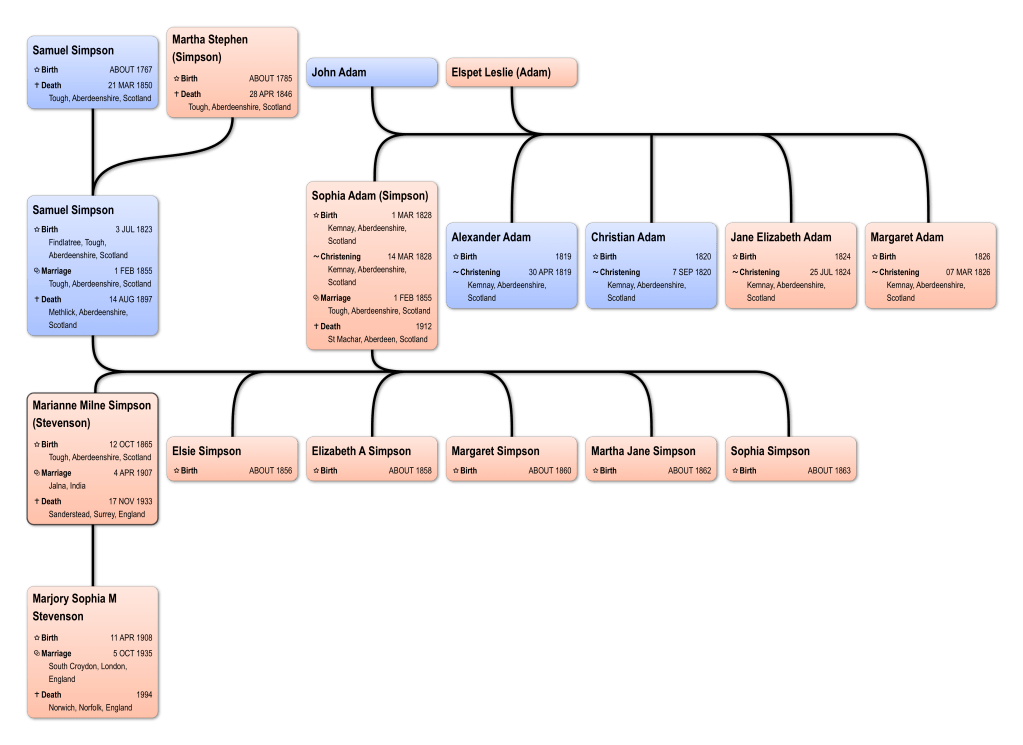
Recall that in 1881, Mary A. Milne (a widow born around 1832 with probably a daughter born around 1863) would be visiting Sophia on census day, and was, I think, the Mary A. Adam who married John Milne in 1861. She is not listed in the OPR index above as a sibling to Sophia after all, and I see no reason why she’d be missing if that’s what she was.
Sophia may have had cousins from Kemnay, however, because as well as a fair few local people called Adam, the name Sophia was chosen by George Adam and Isabel Reid for one of their children, 12 years after Marianne’s mother Sophia Adam had been born in the same parish. Given that Sophia Adam was an unusual name, and that cousins often had a shared name, it’s reasonable to assume a family connection, though I have no indication that John had an older brother called George. He may have had, I have not delved, and I’ll leave these as loose ends for now. A check of the Mary A Adam + John Milne marriage certificate from 1861 and other documentation could provide good evidence. Whoever she was, maybe a godmother, it is likely that it was after her that Marianne Milne Simpson was named in 1865.
Here are the OPR “birth” index entries for George Adam & Isabel Reid’s family in Kemnay, with Mary (A?) Adam (b 1835) as the oldest child:
| ADAM | MARY | F | 10/02/1835 | 207/ | 20 44 |
| ADAM | ISABEL | F | 20/08/1837 | 207/ | 20 44 |
| ADAM | SOPHIA | F | 20/05/1840 | 207/ | 20 44 |
| ADAM | GEORGE | M | 30/05/1842 | 207/ | 20 38 |
| ADAM | GEORGE | M | 25/06/1842 | 207/ | 20 44 |
| ADAM | JANE | F | 05/09/1845 | 207/ | 20 44 |
| ADAM | PETER | M | 15/09/1845 | 207/ | 20 44 |
| ADAM | JOHN | M | 28/07/1851 | 207/ | 20 44 |
Ancestry
Free access over the weekend to ancestry.co.uk has let me build a tree which fits the information above, supplied by their hints and drawing on previous work in the Mighton family tree which my potterings fit with. Excellent! I can refer (and refer any readers) to their work on Marianne’s maternal grandparents John Adam (1784-186) and Elspet(h) Leslie (1789-1856), and paternal grandparents Samuel Simpson (1767-1855) and Martha Steven (1776-1846). No need to copy it into here, or evaluate it! I’ve just accepted one further generation of hints online, and left it there.
Why India?
One thing I wonder is whether it was the death of her father in 1897 that took Marianne to India. Was she looking for work? Adventure or escape after a quiet life? Perhaps she was looking for marriage, or had a plan for her own advancement. Perhaps she had a friend with a connection to India. Sadly, I have no idea. She did have a familiar model for “respectable” life far beyond the stable middle-class rural upbringing she was used to, however.
Thanks to Elizabeth Mielke, who recommends “She-Merchants, Buccaneers & Gentle Women” by Katie Hickman, which traces the history of why British women travelled to India from the early 17th century into the 1900s. It sounds great.
Haddo House
Almost adjacent to the Simpson farm at Wardford, a mile or so to the south east, beyond Methlick on the same, west, side of the river Ythan, was (and still is) beautiful Haddo House. This “stately home” was designed in 1732 by William Adam and remodelled extensively in the 1880s, at the same time that the Simpson children (including Marianne) where reaching adulthood. The National Trust for Scotland say that “As a result, it has the clean elegance and swooping lines of the Georgian style with a luxurious Victorian interior.” It must have been a central topic of conversation and speculation.
The local aristocratic owners were the Gordon family. “George Gordon, 1st Earl of Aberdeen was Lord Chancellor of Scotland; the 4th Earl served as Prime Minister [of Great Britain].” These were the landowners from whom the Simpson farms were rented, and were part of a wealthy and powerful social elite.
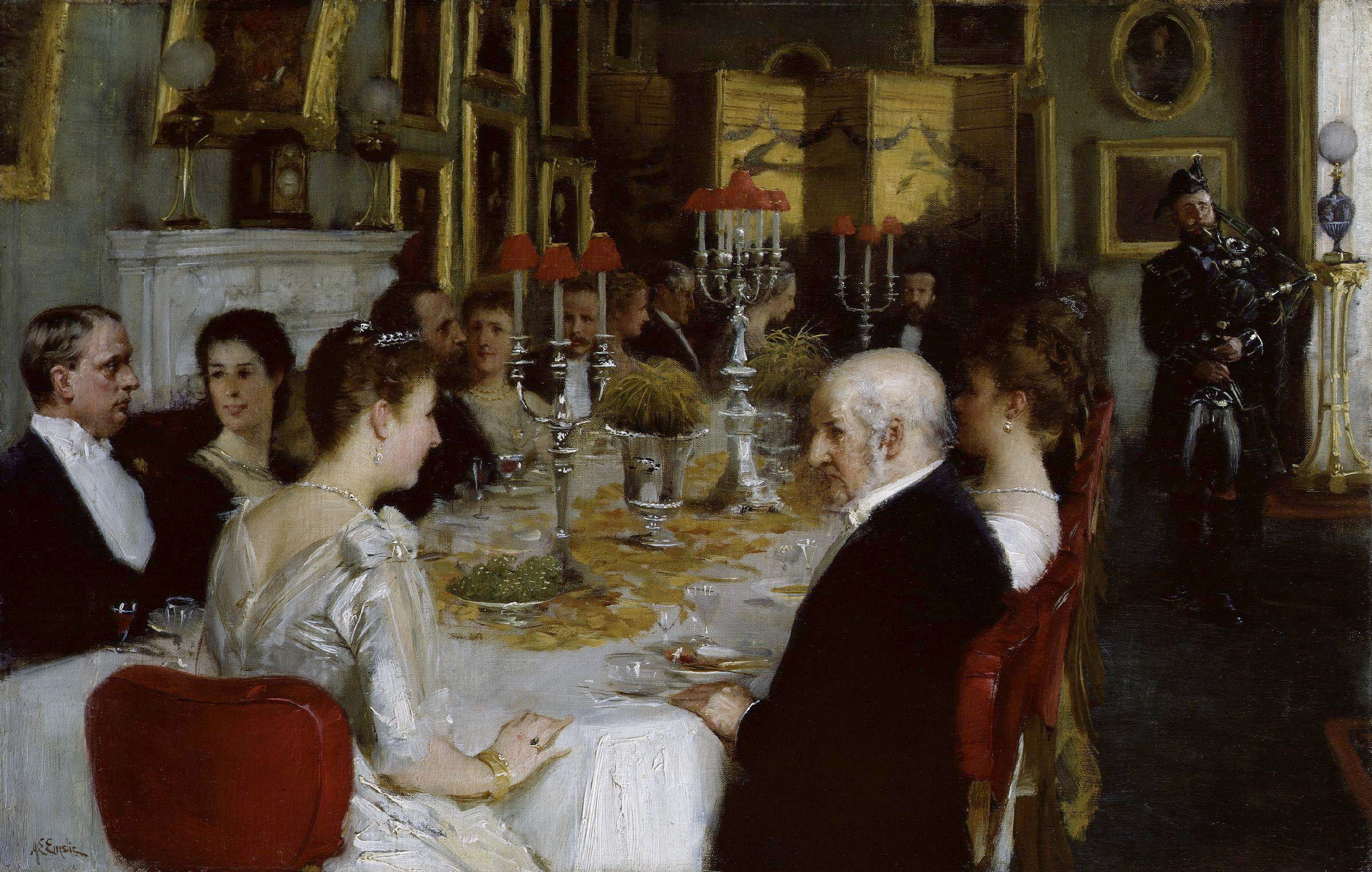
Dinner at Haddo House, 1884, by Alfred Edward Emslie (died 1918) – image from Wikipedia and I think it is public domain but I’m not clear about it.
The original is in the National Portrait Gallery in London.
What do I mean by saying they were a wealthy elite? Wikipedia says “A specially-made display cabinet contains the Cabot Commemorative State Dinner Service. The hand-painted porcelain service with twenty-four settings for an eight-course meal was made by members of the Woman’s Art Association of Canada in 1897. The Canadian government declined to pay the CDN$1,000 asking price. It was purchased privately by members of the House and Senate of Canada and presented on 12 June 1898 to Lady Aberdeen on the occasion of her husband ending his term as Governor-General of Canada.” I think that’s what I mean.
The National Trust for Scotland website highlights something more prosaic, but more meaningful to potential readers of this blog interested in genealogy. They say that Haddo was a maternity hospital during World War II. Over 1,200 babies were born there!
East, west, home’s best
I’m still wondering why, around 1900, Marianne travelled to live in Raj India. Was it accident or design? Push or pull? What were the long-term influences on her, if any?
What is clear is that Marianne retained an emotional connection to the land of her youth, even though she did not live there. As the wife of Dr Stevenson, general practitioner in Sussex, she called her home Ythanbank, a location from her childhood. The wedding of their only child, Marjory, in 1935, was written up in the Aberdeen newspaper. Some family travelled to the far south of England for the event, even though Marianne had died.
Marianne’s husband Jack had also been drawn to the country of his youth: India. That’s why he was there. He’d left it as a child, and he (and his brother) had reason to return to work there, rather than anywhere else. It so happens he met Marianne. They were both a long way from Scotland. Her personal journey was so unlike his! And her Scotland was thoroughly unlike his! Who knows if it was the similarities between them or the differences that they found more attractive. Finally, let’s not forget Marianne’s sister-in-law Bertie, my grandmother: before she was married she lived in a house in Scotland Pachumba (sic), recalling her place of birth so far away.
Bertie was linked to memories of a childhood in India; her sister-in-law Marianne to memories of a childhood in Scotland.
Words, names, and language
Pachumba and Ythanbank. Beautiful names both. Chosen to name homes. Complex words in languages distantly related by thousands of years, and thousands of miles, and echoing each other in two parallel but distinct lives.
In Pachamba, P-A-CH (pronounced similarly to the conventional English spelling) carries the meaning of “five” from Hindi (पाँच) or Bengali (পাঁচ), even though the local people around Pachamba village where the Stevensons were born were Santals, speaking Santali, a non-Indo-European language. Think of penta– (from Greek), or pump (in Welsh), four (in English), fünf (in German), or even, it seems pesë (in Albanian). These are all lip sounds that have evolved a little, while remaining relatively stable in this important, frequent and ancient word.
The lip consonants at the start of the word for “five” evolved from a pre-historic sound that used the lips but also the back of the tongue, and consequently the other stable sound found in Indo-European languages for “five” is a back of the tongue sound like /k/. You can listen to a reconstructed Proto-Indo-European penkwe (never written down or recorded) gradually becoming Latin quinque here in the micro-steps that an alphabet doesn’t represent. At some point in the sequence of equally-altering sounds you will probably suddenly hear a /k/ at the start of the word rather than a /p/. A mutation. In the real world of words-spoken-by-mouths, the balance between different articulations gradually changed – just as is happening today with English consonant /r/, which is becoming more and more labial.
Y-TH-A-N is pronounced like “eye”+”thin”. The “th” is voiceless like the one in “thank”, not voiced like the one in “than” and the second vowel is less stressed and like a schwa vowel. Wikipedia says “the name is believed to have originated from a Pictish word of Brythonic origin meaning gorse”. In Welsh, gorse seems to be eithin.
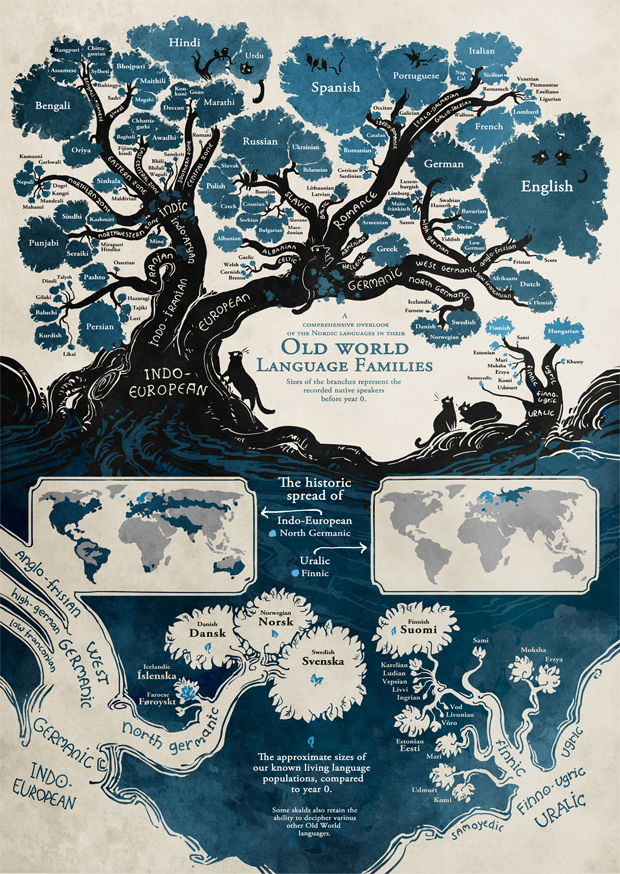
It’s tempting to see language change from a genealogical perspective, but the family tree is not the right metaphor. The difference between human families and language families is that a language diverges from its ancestor through mutation: a newer language is almost entirely descended from an older “mother”-tongue alone (except in the case of creoles). Linguistically, languages are constructed by a community of individuals, and evolve, like species of animals. An individual person, on the other hand, inherits half their biology from each of their two parents.
And at the end of the day, biology doesn’t matter except that it is the default means by which people become parents of a new generation. It’s the parenting that matters. Family, society, and culture matter, not biology.
NOTES and SOURCES
For the introductory image of local countryside, see the original at Geograph.
For access to the Ordnance Survey name books, and more, go to Scotland’s Places. The current OS maps are far better than google maps for farms etc: the latter are often not listed, as I have discovered. Geograph provides a small but zoomable map interface for local searching. Here are some grid references for small places that are harder to find than Kemnay, Cluny and Methlick:
- Findlatree farm: NJ 59655 12979 – E: 359655 N: 812979
- Kirkton of Tough church and graveyard: NJ 61505 12974 – E: 361505 N: 812974
- Mains of Whitehouse: NJ 63125 14382 E: 363125 N: 814382
- Wardford farm: NJ 84039 38120 E: 384039 N: 838120
- Ythanbank (Abderdeenshire): NJ 90492 34157 E: 390492 N: 834157
Thanks to John Urie in Scottish Genealogy for identifying the placename Findlatree from the certificates above, and then also to Scotland’s People for re-scanning and confirming from the original. https://www.facebook.com/groups/sftrscottishgenealogy/
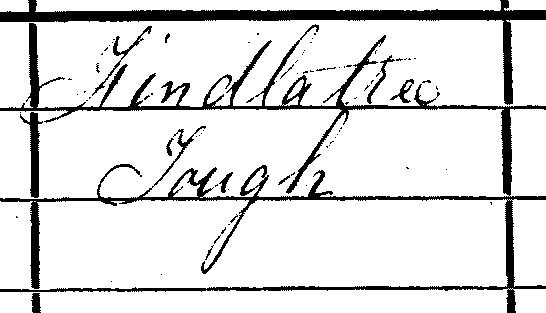
Here is a little youtube video about Haddo https://www.youtube.com/watch?v=psYvWGWJMOY
You can browse Indo-European cognates here, or listen to scientific reconstruction of how ancient words sounded at Ancient Sounds, which also has a table of digit numbers.
See also Omniglot.
Here’s a friendly presentation by Simon Taylor on Scottish placenames.
Some other local genealogy at

William Cassie aged 12 (shepherd from ?Mettlehill), my great grandmother name was Jessie Cassie she married William Barclay, he was a widower and had children. they had my grandmother Williamina I was told her name was Cussie But looking at my Williamina first Child being born registered the birth in her maiden name Jessie Cassie /Cussie never found any reference to a Cussie so it must have been Cassie I do have photographs of her and my grandmother. they were from Peterhead. there were two girls taken out of the workhouse to live with my great grandparents but a boy their brother left in the workhouse. I do have the names of the girl but only first names and no name for the boy. there was some relationship between those girls and my great grandmother. I am wondering now if William Cassie aged 12 you talk about the boy left behind in the workhouse?. Have you looked at the workhouse records? I cannot get at my research to look up any more information as I am having treatment for breast cancer and can not get at it.
LikeLike
First off, good luck with your treatment.
As for William the shepherd boy – that’s an intriguing possibility, isn’t it! No, I don’t know anything about him. I’ll add an image of the census information – perhaps that will help with the place of birth at least. Maybe it will look familiar. Right, I can see now another person on that same page from Methlick, and the heading at the top of the page: the script mis-led me to guess at Mettlehill, oops. I had previously wondered if it was “Methlick” but found no births for a Cassie (fuzzy search) in the 19th C., which is one reason why I thought that the census did not say he was from Methlick.
So – census does in fact say the boy was from Methlick, even though there is in fact no birth in Methlick for anyone called Cassie (or similar). Assuming his age is about right, and that he was born between 1868-1870, there are just three hits for a William Cassie birth in the index. Fyvie 1869. Banff 1870 and Old Machar Aberdeen Burgh 1871. Fyvie is only 7 miles from Methlick, so he looks the best bet as the shepherd. There seems to be a couple of Cassie families with a number of kids in Fyvie at that time.
LikeLike
I’m curious if you have established where the Milne part of her name came from? I note that you have an Elspet Leslie marrying John Adam and I’m wondering whether this might be a possible connection to one of my brick walls.
I have Margaret Milne marrying Peter Leslie in Ellon in 1792. They are my 5xg grandparents. Their daughter, Mary Leslie had a child with a William Mitchell (out of wedlock it appears). However I’ve had some difficulty establishing whether Mary had any siblings. I’ve also had difficulty finding definitive records of either Margaret or Peter other than their marriage record. Therefore I’m kind of hoping that Elspet might be their child (which would account for why her daughter went on to use Milne as a middle name for Marianne.
If you think there could be a connection, please get in touch with me via my blog or email me at lookingforwardlookingback@outlook.com.au.
LikeLiked by 1 person
Good question! It’s an intriguing possibility. I assumed that Mary A. Milne born in Kemnay around 1832 was a relative of Sophia Adam, because of a marriage between a Mary A. Adam to a John Milne in 1831. But I’ve not done any research, and it would have been better if Mary A Milne had been nee Adam and the sister of Sophia Adam. But I suspect they were not sisters (but I have assumed they were both born with the surname Adam).
Why would Sophia call her daughter Marianne Milne Simpson? The dates of the Adam+Milne wedding & birth of Marianne were fairly close. The only reasons I can think of are that Mary Milne was a godmother, and/or that John had just died.
Your idea could work too. It would mean Mary A. Milne (b1832) was someone not blood-related to Olivia Adam, but just someone married to a man whose surname Milne is the link to Olivia, perhaps as you suggest.
If I go to Scotland’s People on a day out over the summer, these are options to explore.
LikeLike
Good luck! I though you have a break-through with it. And if you do find a connection with me, please get back in touch 🙂
LikeLiked by 1 person